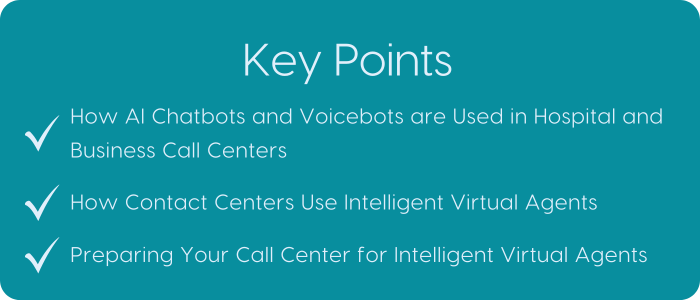All types of organizations and businesses integrate artificial intelligence (AI) technology to handle phone, web, and text inquiries to improve efficiency and customer or patient satisfaction.
Even though chatbots seem like a more recent concept, chatbots first emerged with programs like ELIZA in the 1960s intended to mimic a conversation with a therapist. Text-based chatbots were developed in the 1980s and 1990s and began to rise in the late 1990s and early 2000s with scripted chatbots.
As AI and natural language processing (NLP) advanced, particularly in the late 2010s and into the 2020s, chatbots and voicebots became much more capable. Large language models (LLMs) like GPT-3 and subsequent models have significantly increased the ability of these kinds of bots to engage in complex and nuanced conversations.
Today, intelligent virtual agents (IVAs) are already replacing AI bots. While both AI chatbots/voicebots and IVAs perform similar tasks, they are not the same. We’ll examine some of the differences between AI bots and IVAs so you can decide which technology is best for your call center.

How AI Chatbots and Voicebots are Used in Hospital and Business Call Centers
AI chatbots and voicebots often serve as the first point of contact during phone, website, or text interactions. After the initial greeting, they triage the encounter by asking questions to understand a person’s needs. Bots can quickly categorize inquiries and direct people to relevant resources, such as FAQs, knowledge base articles, or specific web pages.
This triage process reduces the workload on human agents by filtering out simple, repetitive inquiries such as:
- Answering FAQs and Providing Information: Bots are programmed with vast databases of information, enabling them to answer common questions about products, services, appointments, and procedures. They can provide real-time information, such as appointment availability, order status, account balances, or shipping details.
- Automated Call Routing: When powered by NLP, voicebots are used to enhance traditional Interactive Voice Response (IVR) systems. Instead of navigating complex menu options, callers can speak their inquiries in natural language. They understand the caller’s intent and route the call to the appropriate department or agent.
- Guiding Users Through Processes: Assist people with filling out forms, making appointments, or completing transactions. They can provide step-by-step instructions and answer questions along the way, reducing the likelihood of errors.
- Collecting Customer or Patient Data: Collect valuable data, such as contact information, preferences, and feedback. This data can be used to personalize future interactions and improve service.
- Transfer to Human Agents: When a chatbot or voicebot can’t resolve an issue, they can simply transfer the person to a live agent.

Chatbots and voicebots benefit call centers by reducing wait times, increasing efficiency with automation, and providing 24/7 support, which improves customer and patient satisfaction. With the help of bots, more services can be provided even when call centers are short-staffed while easing the workloads for human agents.
How Contact Centers Use Intelligent Virtual Agents
Contact centers often opt for IVAs over basic chatbots and voicebots due to the IVA’s enhanced capabilities in handling complex interactions. IVAs, powered by advanced AI like NLP and machine learning (ML), can understand nuanced language and context that require a deeper understanding. IVAs can navigate these complexities that go beyond simple FAQs more effectively than chatbots.
In addition to handling all of the tasks a chatbot or voice bot can perform, IVAs can also integrate with customer relationship management (CRM) systems to access customer data, enabling personalized interactions that can’t be done with a bot. The voice tones used by IVAs are friendly and offer a multitude of different sounding voices to make calls more engaging.

This personalization leads to higher caller satisfaction because IVAs can provide tailored solutions and anticipate someone’s needs. Busy agents get some relief from their workloads. IVAs are able to:
- Automate complex tasks, such as processing transactions, updating account information, and scheduling appointments. This automation provides services to callers while reducing the workload on human agents, allowing them to focus on more complex and high-value interactions.
- Improve efficiency by handling routine and complex inquiries to significantly reduce call volumes and wait times. This streamlined workflow translates to lower operational costs for the call center.
- Continuously learn and improve from every interaction to increase their accuracy and effectiveness. This adaptability ensures that the system stays current and relevant.
- Seamlessly transition to human operators without losing any data by providing the agent with the call history and relevant information to ensure a smooth transfer and avoid the need to repeat information.
In essence, while chatbots excel at handling simple, repetitive tasks, IVAs are better equipped to handle the dynamic and complex nature of call center interactions, leading to improved customer satisfaction and operational efficiency.
Preparing Your Call Center for Intelligent Virtual Agents
Upgrading a call center from basic chatbots and voicebots to intelligent virtual agents involves a step up in complexity and capability. Your call center may have to update its current system to support the more powerful tools IVAs provide. Legacy systems may need to be replaced, but call centers with modern, cloud-based infrastructure and open APIs can more easily integrate IVAs.
Below, we offer a comparison of some key factors and considerations involved.
Complexity of AI
Chatbots often rely on rule-based systems or basic NLP. However, IVAs utilize more advanced AI, including sophisticated NLP, ML, and deep learning, to understand context,
sentiment, and intent more accurately. This requires more robust underlying technology.
Voice Capabilities
While chatbots handle text-based interactions, IVAs are designed for voice interactions. They require advanced speech recognition and text-to-speech capabilities, which adds a significant layer of technical complexity.
Integration
To provide personalized and context-aware interactions, IVAs typically require deeper integration with existing call center systems, such as CRM, IVR, and knowledge bases. This integration can be a complex undertaking.
Data and Training
IVAs require large amounts of data to train their AI models effectively. Call centers must have the infrastructure and expertise to collect, process, and analyze this data.
Vendor Support
Vendors that offer comprehensive support, including implementation, training, and ongoing maintenance, can simplify the upgrade process.
While the progression from chatbots and voicebots to IVAs is logical, it is not always a simple process. It requires careful planning, investment in advanced technology, and skilled personnel. However, the potential benefits, such as improved customer and patient satisfaction and increased efficiency, can make the upgrade worthwhile.



